Vacuum purging is an essential component when creating high-quality cannabis concentrates. Vacuum purging solvent-based extracts removes residual solvents from light hydrocarbon extraction products to improve consistency, texture, color, and purity. The result is a translucent and pristine concentrate that’s both potent and safe for consumers.
A vacuum oven and pump allow concentrate manufacturers to “off-gas,” or evaporate, chemicals at low temperatures from cannabis oil products, thereby preserving the plant’s therapeutic cannabinoids, terpenes, flavonoids, and other full-spectrum compounds necessary for a whole-plant experience.
Be sure to also check out part one in this series, BHO 101.
.png?width=1200&name=Untitled%20design%20(26).png)
What Is a Vacuum Oven?
Contrary to popular belief, vacuum ovens weren’t solely invented for the removal of solvents from BHO or CO2 concentrates. Vacuum ovens are used in numerous critical and highly-sensitive industries to remove unwanted substances from products. Conventional purging systems include a vacuum chamber, a lab-grade heating plate/surface, and an adjoining vacuum pump to remove the evaporated solvent.
What Is Vacuum Purging?
Across various industries, vacuum purging is used to remove substances/chemicals from samples using low temperatures, depending on the type of extract being produced. Under pressure, butane, propane, and other solvents convert into a gaseous form and evaporate, also known as “off-gassing.” The result is a 0ppm residual solvent cannabis oil ready for consumption.
Vacuum purging works by lowering the atmospheric pressure in a vacuum chamber/oven. Atmospheric pressure is the weight of the air above a certain surface area. As the pressure decreases in the oven, the volatility increases allowing chemicals to boil off at lower temperatures without degrading the temperature-sensitive compounds in cannabis.
Vacuum ovens measure atmospheric pressure in inches of mercury, denoted as inHG or HG. Extraction equipment operators will set the vacuum oven as close to -29.92inHG as possible. At this pressure, a vacuum is created. Commercial vacuum ovens will be more capable of maintaining a consistent vacuum and removing solvents.
Industrial Purposes
Before vacuum ovens became a vital part of the BHO extraction post-process, their effective and versatile technology were and continue to be used in the medical devices, electronics, and aerospace manufacturing industries. Industrial-grade vacuum ovens and pumps are used to remove solvents, lubricants, epoxies, and other chemicals from their products.
Instead of relying on one large vacuum oven, large-scale manufacturing facilities operate multiple, smaller vacuum oven and pump stations. The batch-processing system ensures resources are used in a safe and effective manner that maximizes throughput and quality.
Scaled and Consistent Post-Processing
Performing a BHO vacuum purge offers extract artists numerous benefits including increased throughput in order to scale production. Professional vacuum ovens include a large surface area within the chamber for manufacturers to purge the largest amount of concentrate as possible.
Vacuum ovens can also come with one or multiple shelves allowing operators to off-gas multiple dishes/surfaces containing cannabis resin. Additionally, BHO vacuum ovens provide consistent and even heating to every inch of the product. The result is an efficient and speedy process without any buttering up in certain areas.
See our article on residual solvents to understand how much solvent is removed by this process.
Vacuum Purging Workflow
The main function of using vacuum purging for closed-loop BHO extraction is to remove any residual solvents from the final product. Vacuum ovens allow manufacturers to use the least amount of heat as possible to release the trapped solvent. Purging typically occurs between 85º and 105º F. The temperatures use depend on the viscosity and thickness of the “slab.”
Generally, operators may begin with an initial purge, after which, samples can be tested after about 8 hours of purging. Concentrates should have all the solvent removed between 24 and 36 hours. Purges that take longer than 36 hours can be indicative of thick slabs or infrequent flips of the solid slab (every few hours) to speed up the purging process.
After installation, powering on the vacuum oven, and making sure the vent and vacuum valves are closed, operators can turn on and begin processing oil. Once the machine is on, the operators will leave the vacuum valve open during the entire purging process. Leaving the valve open allows the solvent to evaporate out of the chamber.
Extraction technicians will also flip the solid slab during post-processing to expose more surface area to the heat. After the purging process is done, operators will close the vacuum valve and open the vent valve to release the vacuum in the oven. Once the digital vacuum gauge is back to zero, operators will close the vent valve and take out the solvent-free concentrate.
Vacuum Oven Solutions
Vacuum oven solutions for post-processing cannabis oil come in all shapes and sizes. Operators can choose between ovens made of various thermal-conductive surfaces. Industry experts recommend obtaining a vacuum oven with solid aluminum shelves instead of stainless steel for thermal conduction or wire racks like the ones used in convection ovens.
An in-oven temperature probe can give operators a near precise temperature reading. Some probes may be more effective than others, depending on where the probe is located such as inside the wall or touching the shelves. Professional-grade equipment tries to get as close to the product to get an accurate reading and proper purging.
The recommended vacuum pumps option is an oil-free pump that can tolerate the temperatures and pressures involved in the purging process. Oil-sealed pumps can leak oil and ruin the final product. Many vacuum ovens also feature a high limit protector to turn off the system in case of temperatures reaching above the desired limit or system failure.
Luna Technologies: Light Hydrocarbon Extraction
From seed to oil, every aspect of the supply chain must meet the highest standards to produce premium concentrates for an increasingly discerning market. Luna Technologies offers manufacturers fully-automated, light hydrocarbon extraction equipment. As states continue to refine regulations, extraction equipment must feature approved gas monitoring, ventilation, and emergency stop button solutions.
An automated light hydrocarbon extractor and vacuum oven are necessary to eliminate bottlenecks in production and produce a full-spectrum concentrate. Our IO Extractor offers an error-free experience and an increased ability to diversify a concentrate product line. Learn more about the IO Extractor here.




